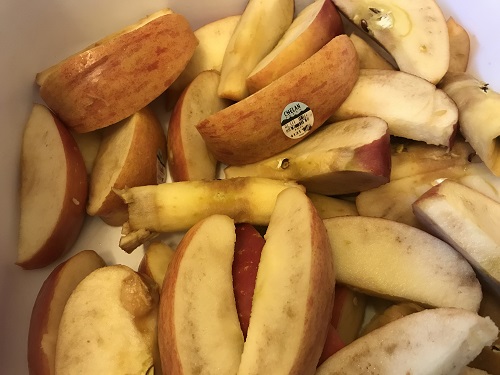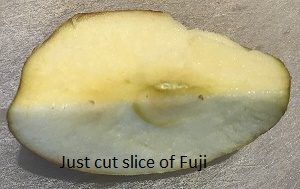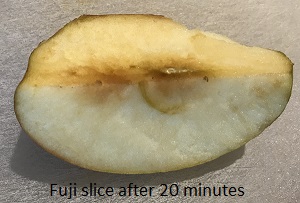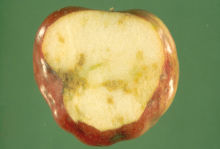
Looking for Apples: Why Are Some Brown Inside (But look Good Outside) in 2025? Scroll down this page and follow the links. And if you bring home some fruit or vegetables and want to can, freeze, make jam, salsa or pickles, see this page for simple, reliable, illustrated canning, freezing or preserving directions. There are plenty of other related resources, click on the resources dropdown above. If you are having a hard time finding canning lids, I've used these, and they're a great price & ship in 2 days.
If you have questions or feedback, please let me know! There are affiliate links on this page. Read our disclosure policy to learn more.
Apples: Why Are Some Brown Inside (But look Good Outside)
Apples: Why Are Some Brown Inside (But look Good Outside)
Have you bought apples (especially Fuji) that look great and when you get them how and cut them open, you find they are brown or have brown spots inside? This is becoming a more common problem, and unscrupulous (or simply incompetent) middlemen may be at the heart of it. It has to do with how the apples are stored after they are harvested.
Storage-Caused Browning, CO2 damage:
If the apple looks great on the outside, no brown spots, blemishes, etc. - but is brown inside
In this case, the most common problem is due to how the apples were handled in storage after being harvested. UC Davis tells us:
Internal browning, thought to result from CO2 injury, has been reported in Fuji, Cox's Orange Pippin, Braeburn and Jonathan apples. The disorder is associated with later harvested, large, and overmature fruit and with CO2 concentrations in storage. Higher concentrations of CO2 result in greater incidence and severity of internal browning. Incidence and severity of this disorder varies season to season and orchard to orchard. The reasons for this variability are unknown but some have suggested an association with cool, wet weather and high nitrogen fertilization.
 This
makes sense to me. I bought 3 bushels of Fuji's in late September
2019 at the farmers market. They were exceptionally large (the
size of softballs or grapefruit), and looked and felt perfect on the
outside. When I cut them out, 1/3 to 1/2 of them looks like
this:
This
makes sense to me. I bought 3 bushels of Fuji's in late September
2019 at the farmers market. They were exceptionally large (the
size of softballs or grapefruit), and looked and felt perfect on the
outside. When I cut them out, 1/3 to 1/2 of them looks like
this:
When you look at this photo, understand that I took this picture with 90 seconds of cutting these apples. This is NOT due to air exposure, where apples brown after being cut and exposed to oxygen. That takes longer than a minute or due, this is how the apples look the moment they are cut open.
I cut a piece of the white portion of one of these apples and tasted it. It had a mealy, mushy texture and tasted bland.. not bad, but simply flavorless.
The degree of browning varied from faint brown to quite dark.
Firm Flesh Browning
Empire and McIntosh apples and presumably, Fuji, are susceptible when they are stored for too long in cold temperatures. It looks a lot like the browning caused by CO2issues (shown above), affecting the core and flesh. A key difference is there is no clear boundary between the afflicted flesh and the undamaged areas; they blend together. U of Maine says that it occurs more frequently when the apples are harvested late (for the variety) and a storage compound, 1-MCP, is used.
Soggy Breakdown caused by too cold storage
The University of Maine has a page that shows and explains several apple browning problems, including "Soggy Breakdown.
They tell us:
Soggy breakdown is an internal chilling injury that develops when susceptible varieties of apple are stored at a temperature below their tolerance. For Honeycrisp, temperatures below 37ºF can induce this disorder. Browning develops in the outer cortex. Severity of symptoms range from small brown spots in the cortex to a complete ring of browning around the entire apple that usually does not extend to the skin. There is usually ring of unaffected tissue just inside the skin. In Honeycrisp, it often co-occurs with soft scald. Conditioning the fruit before placement in cold storage does not consistently prevent soggy breakdown and in some cases, can make it more severe. It is recommended that Honeycrisp be stored at temperatures of 37 to 38ºF.
 Ordinary
Browning
Ordinary
Browning
Compare the CO2 issue above with ordinary browning , or "enzymatic browning." When you cut open an apple, the flesh is first now exposed to oxygen. An enzyme in the apple called polyphenol oxidase (PPO) starts to oxidize compounds in the apple's flesh called polyphenols.
The oxidized polyphenols are transformed into "o-quinones" , which then react with amino acids in the apples to produce the brown color.
Some apple varieties have more of the enzymes and the polyphenols
which means they brown more. Some new varieties have been bred
to have lower levels of these compounds and stay white after cut.
The browning does not affect flavor or even texture. Sure, if
you leave cut apples out for a day ,
that would, but that's due to actual rotting, not a simple enzymatic
color change.
,
that would, but that's due to actual rotting, not a simple enzymatic
color change.
This enzymatic browning also occurs in other
fruit, most noticeably bananas, pears and eggplants.
If you want to keep enzymatic browning to a minimum, see this page for simple tips that work!
At right is a photo of ordinary air-exposed browning, top a fresh cut Fuji apple and bottom the same slice, 20 minutes later.
See this page for a time lapse set of photos showing how an apple slice browns once cut.
Both slices are perfectly fine to eat!
Other causes of apple browning problems
Apple maggot damage
If a female apple maggot lays an egg in a growing apple, it leaves a dimple or small spot where the egg is laid. Once the egg hatches, the maggot eats some of the apple flesh. This causes brown spots inside the apple. The apple maggot leaves the apple (so you won't find one inside, just the brown damaged flesh).
Bitter Pit
Bitter pit shows up as recessed small brown divots in the outside surface of the apple, sort of like the dimples on a golf ball, but dark brown in color. There are also brown spots inside the apple's flesh. It is caused by a calcium deficiency in the fruit and can appear while the fruit is still on the tree or appear within the first month or two of cold storage. Most susceptible varieties include Honeycrisp, Northern Spy, Gravenstein, Grimes Golden, and Baldwin and to a lesser degree Golden Delicious. Red Delicious, Gala, and Winesap and more resistant. See this page for photos.
Soft scald
Another chilling disorder that affects Honeycrisp, Golden Delicious and McIntosh apples when they are stored at temperatures below their tolerance. It looks like a blister or light brown discoloration of the skin and then can become dark, affect the flesh beneath and eventually produce fungal decay.
Superficial scald
This damage DOES affect the outside, causing visible browning when certain apple varieties are stored longer than three months in cold storage. Brown splotches develop on the green side of the apple, and will continue to grow in size when the apple is held at warm temperatures. It is also associated with early harvest date. Cortland, Red Delicious, McIntosh, and Granny Smith are most susceptible.
Senescent breakdown
This is simply due to the apple being too old, stored for too long. How long is too long varies from one variety to the next. Fuji's store well, but Macoun shows signs with 2 months. All varieties will eventually develop senescent breakdown if stored long enough. Commercial apple stores use the proper temperature (which is specific top each variety), harvesting at proper maturity, a controlled atmosphere (e.g., CO23 levels) and, in some cases the use of a compound called 1-MCP to delay it.
What can you do with browned apples?
If the apples look ok when you cut them, and start to brown only after being cut; they're fine - THAT IS NORMAL!
But for the apples that are brown inside when you cut them open, there's not much you can do. I wouldn't use them, First off, they taste awful! They may not be harmful to eat, but what's the point if they taste bad?
How can you prevent browning of apples at home?
The normal browning CAN be easily reduced or eliminated; see this page.
References
- University of California at Davis -
- University of Maine Cooperative Extension - Lots of good example photos here and explanations of causes
- University of Minnesota - Apple Maggots
- Pacific Northwest Pest Management Handbooks - Bitter Pit
Looking for canning equipment and supplies?
Water bath canner with a jar rack
Pressure canners for gas, electric and induction stoves: Presto 23Qt or T-fal 22Qt
Canning scoop (this one is PERFECT)
Ball Blue book (most recent version)
Jars: 8oz canning jars for jams
Find Other types of farms:
Farm markets and roadside stands
Road trips and camping resources
Local Honey, apiaries, beekeepers
Consumer fraud and scams information
Home canning supplies at the best prices on the internet!
Maple Syrup Farms, sugarworks, maple syrup festivals
Environmental information and resources
Farms For Your Event for birthday parties, weddings, receptions, business meetings, retreats, etc.
Festivals - local fruit and vegetable festivals
Get the
most recent version of
the Ball Blue Book
With this Presto 23 quart pressure canner and pressure cooker, you can "can" everything, fruits, vegetables, jams, jellies, salsa, applesauce, pickles, even meats, soups, stews. Model 01781

You can make jams, jellies, can fruit, applesauce, salsa and pickles with water bath canners, like this Granite Ware 12-Piece Canner Kit, Jar Rack, Blancher, Colander and 5 piece Canning Tool Set

